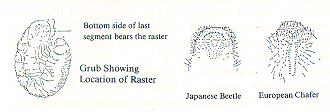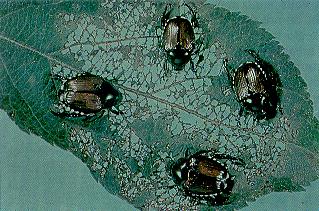Japanese beetles in nursery and turf
Learn about the life history, damage caused, monitoring and management strategies for Japanese beetles in nursery and turf.
Description
Japanese beetle (Popillia japonica) adults are about 13 mm in length and easily identified by their bright, metallic green head and thorax, metallic brown to copper wings tinged with green edges and six tufts of white hairs along either side of the abdomen (Figure 2). Like the grubs of other scarab beetles such as June beetle and European chafer, the Japanese beetle grubs are milky white, "C"-shaped grubs about 2 cm in length. The head is brown, and the body has three pairs of legs. It can be identified from other white grubs by examining the arrangement of the spines on the underside of the last abdominal segment called the raster. The spines of Japanese beetle form a "V" shape (Figure 1).
Figure 1. Arrangement of Spines on the Rasters of Japanese Beetle and European Chafer.
Distribution
In the U.S., the beetle can be found in several states. In Canada, parts of southern Ontario and some isolated areas of Quebec have established populations. A mean summer soil temperature of 17.5 °C to 27.5 °C and a mean winter soil temperature of about - 9.4 °C as well as a uniform summer precipitation of 25 cm seem to govern the limits of its spread. The Niagara Peninsula and Hamilton-Wentworth region, have been identified by Agriculture Canada to have resident beetle populations.
Damage
Adult beetles skeletonize foliage (Figure 2).
Figure 2. Adult Japanese Beetles. Note skeletonized leaves resulting from feeding by the adults.
While adults do not damage turf, they do feed on foliage and fruit of about 300 species of plants (see Table 1). Members of the rose family are preferred hosts as well as maple, Acer; birch, Betula; mountain ash, Sorbus; linden, Tilia; and fruit trees such as apples Malus; cherries, peaches, plums, Prunus; grapes, Vitis and blueberries, Vaccinium. Some plants such as geranium, Pelargonium; castor bean, Ricinus communis, and flowers of bottlebrush buckeye, Aesculus parviflora, cause paralysis and death of adults.
Larval feeding on the fibrous roots of grasses makes this stage a destructive pest for turf. Injured turf initially wilts and yellows during August and September. As the damage progresses, dead patches of turf can be observed. Often confused with drought stress, these affected areas can be lifted and pulled back to reveal the grubs beneath. Grubs will also feed on the roots of ornamentals and vegetables.
Life Cycle
There is only one generation per year. Adults emerge from the soil in late June through mid-July, feeding actively in sunny locations for 30-45 days. A temperature of 21°C and a relative humidity of 60% are ideal for beetle flight. When temperatures exceed 35 °C and relative humidity is greater than 60%, flight ceases. Beetles can fly up to 1.6 km; even flights of 8 km have been noted with a good wind. Some areas in the United States have recorded a spread of 16-24 km per year. Beetles usually feed and mate during the morning and return to the soil in the late afternoon and evening.
While areas of turf and pasture are preferred locations for depositing eggs, they may also be laid in cultivated fields of rye, corn, beans, tomatoes or nursery stock, especially if adjacent grassy areas are dry and hard. Since moisture is crucial to egg hatch and larval development, during periods of deficient rainfall eggs may be laid in poorly drained ground, irrigated areas, or fallow fields where loose soil allows for the easy deposition of eggs. Egg laying continues until late July and August. Eggs hatch in about two weeks. Under dry conditions, eggs and larvae fail to develop. If there is adequate moisture, newly hatched grubs feed on fine roots in the upper 5-10 cm of soil. In drier or cultivated soils, grubs will be found lower in the soil profile.
In September, as soils begin to cool, grubs move deeper into the soil and remain where the soil is about 10oC at a depth of about 15-25 cm. In cultivated soils, this may be deeper, up to 25-30 cm. Lack of snow cover may increase larvae mortality. As soils warm in the spring, grubs move to the surface to feed for 3-4 weeks before pupating in late May and early June. Vertical distribution of grubs within the soil profile depends mostly on temperature and, to some degree, on moisture. Horizontal movement depends on the presence of fibrous roots.
Control
Control strategies should be planned to discourage and prevent adult beetles from laying eggs in nursery fields. Since eggs are usually laid in grassy areas, clean cultivation may discourage egg laying. Clean cultivating soils may also help reduce populations by bringing eggs and grubs to the surface, exposing them to sun, wind and predators. Cultivating should coincide with grubs feeding close to the soil surface in early fall or late spring. It has also been noted that while adults may prefer to feed on clover and alfalfa, grubs do not thrive well or rarely feed on white, red, or alsike clover, buckwheat, alfalfa, oats, barley, common rye and orchard grass. These may be possible ground covers to discourage grub populations. Many weeds are hosts to adult Japanese beetles and grassy or weedy areas surrounding fields may act as potential breeding grounds for the pest. Maintaining good weed control will help eliminate potential food sources.
Some biological controls do exist, however, they are not effective under Ontario's climatic conditions. Milky spore disease, Bacillus popilliae, is a naturally occurring bacteria which was isolated in 1933 from infected grubs. Once attacked by B. popilliae, grubs slowly become weaker. This bacteria is not registered in Canada.
The use of entomogenous nematodes to treat the soil to help control grubs is being evaluated and may prove useful in the future. However, they will not become established and would have to be re-applied. Applying nematodes requires adequate moisture before and after application and soil temperatures of no less than 11°C. Nematodes may have potential in treating containers or rootballs. The cost may also be prohibitive.
It was thought at one time that pH and liming may control egg laying and larvae survival, however, research has failed to support this idea.
Adjusting irrigation schedules to keep the soil conditions drier during egg laying, hatch and larval development may help to reduce populations. In turf areas, maintaining adequate fertility and soil moisture will lessen the impact of root injury.
Apply insecticide treatments in mid- to late July when adult beetles are active. Since adult beetle flight is optimal at 21°C, spraying in the morning or in the mid- to late afternoon may provide better control.
Insecticide treatments on turf should be applied when grubs are young and actively feeding near the Soil surface in late July to mid-September. Apply insecticides to moist soils and immediately after spraying, irrigate the treated areas with 1 to 2 cm of water to wash the product into underlying soil. Control is required if approximately 5 to 10 grubs per 0.1 m2 in non-irrigated turf or 20 grubs per 0.1 m2 on irrigated turf are observed.
Current recommended chemical control may be found in OMAFRA Publication 840 Crop Protection Guide for Nursery and Landscape Plants and Publication 384, Recommendations for Turfgrass Management. For further information consult the pesticide label.
Excluding adult beetles from production sites may be an option to avoid egg laying. Use of shade cloth over hoop houses would keep adults out of containers. By preventing adult beetles from emerging from the soil, one may be able to reduce the population.
Growers should be aware of potential breeding grounds close to production sites and anticipate beetle presence to start monitoring for control programs.
Monitoring
Monitor preferred plant host species to find out when adult beetle activity has started. Beetles will feed on leaves, fruits and flowers. Wild grape, Vitis riparia, is a good indicator of beetle feeding. It has been noted that after emergence, adults will feed on shorter plants first, for example weeds, and then move to taller plants later in the season. Adults emerge around the time that Hydrangea arborescens 'Grandiflora'; Cirsium arvense, Canada thistle; Cichorium intybus, chicory; Daucus carota, Queen Anne's lace; Aesculus parviflora, bottlebrush buckeye; Sambcus canadensis, elderberry or Yucca filamentosa, Adam's needle yucca are blooming (Orton, D.A. Coincide, Plantsmen's Publication, 1989).
Traps using a combination of both female sex attractants (pheromones) and floral lures may be used to capture male beetles. Both attractants must be used together and traps should be placed every 2000 m2 (/acre) from late June to mid-September. Traps should be checked weekly. Some research indicates that even when the most effective sex attractants are used, beetles will prefer to go to nearby host plants.
Summary
- Know the pest - adult and larval stages.
- Monitor adults in early July and for larvae
- prior to digging and
- during digging operations.
- Spray or trap adults to reduce populations and potential egg laying activity.
Causes of Severe Injury to Woody Plants
- Acer palmatum, Japanese maple
- A. platanoides, Norway maple
- Aesculus hippocastranum, horsechestnut
- Betula populifolia, gray birch
- Castanea dentata, American chestnut
- Clethra alnifolia, summersweet
- Hiciscus syrniacus, shrub hibiscus
- Juglans nigra, black walnut
- Kerria japonica, kerria
- Malus floribunda, Japanese flowering crab
- M. sylvestris, apple
- Parthenocissus quinquefolia, Virginia creeper
- Platanus acerfolia, London planetree
- Prunus cerasus, sour cherry
- P. domestica, common plum
- P. persica, peach
- P. salicina, Japanese plum
- P. sertonia, black cherry
- Populus nigra 'Italica", Lombardy poplar
- Salix discolor, pussy willow
- Sorbus americana, American mountainash
- Tilia Americana, American linden
- Ulmus Americana, American elm
- U. campestris, English elm
- Vaccinium spp., blueberry
- Vitis aestivalis, summer grape
- V. lubrusca, fox grape
- V. vinifera, European grape
Causes of Moderate Injury to Woody Plants
- Aesculus parviflora, bottle brush buckeye
- Alnus glutinosa, European alder
- Betula davidii, butterflybush
- Catalpa bignonioides, southern catalpa
- Cephalanthus occidentalis, buttonbush
- Chaenomeles speciosa, flowering quince
- Larix decidua, European larch
- Platanus occidentalis, American planetree
- Prunus serrulata, oriental cherry
- Quercus palustris, pin oak
- Ribes sativum, garden currant
- Rubus argutus, highbush blackberry
- Rubus spp., raspberry
- Salix babylonica, Babylon weeping willow
- S. cordata, heartleaf willow
- Tilia cordata, little leaf European linden
- Viburnum dentatum arrowwood
Causes of Severe Injury to Herbaceous Plants
- Alcea officinalis, marsh mallow
- A. rosea, hollyhock
- Asparagus officinalis, garden asparagus
- Hibiscus moscheutos, common rosemallow
- Largerstroemia indica, common crapemyrtle
- Malva rotundiflora, common mallow
- Oenothera biennis, evening primrose
- Polygomun orientale, princeplume
- P. pensylvanicum, Pennsylvania smartweed
- Rheum rhaponticum, common rhubarb
- Rhus radicans, poison ivy
- Glycine max, soybean
- Zea mays, sweet corn
Causes of Moderate Injury to Herbaceous Plants
- Abutilon theophrasti, velvetleaf
- Ambrosia artemisiifolia, ragweed
- A. trifida, giant ragweed
- Brassica spp., broccoli
- Canna indica, canna
- Dahlia sp., dahlia
- Hibiscus trionum, flower-of-an-hour
- Hypericum perforatum, St. John's-wort
- Medicago sativa, alfalfa
- Mirabilis jalapa, common four-o'clock
- Osmunda cinnamomea, cinnamon fern
- Pettandra virginica, Virginia arrow-arum
- Phaseolus vulgaris, common bean
- Polygonum arifolium, broadleaf tearthumb
- P. convolvulus, wild buckwheat
- P. dumetorum, black buckbind
- P. hydropiper, smartweed
- P. persicaria, lady's thumb
- P. scandens, rough buckbind
- P. cuspidatum, Japanese feece flower
- Pontederia cordata, pickerelweed
- Pteridium aquilinum, bracken
- Rhexia virginica, common meadowbeauty
- Tagetes patula, French marigold
- Trifolium hybrdum, alsike clover
- T. pratense, red clover
- Zinnia elegans, common zinnia
(Adapted from Hawley, I.M. & F.W. Metzger, 1940. Feeding Habits of the Adult Japanese Beetle, USDA circular 547.)

